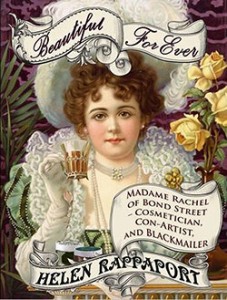Beautiful For Ever
Madame Rachel of Bond Street – Cosmetician, Con-Artist and Blackmailer
by Helen Rappaport (Long Barn Books, 2011) paperback, rrp £8.99
Reviewed by Issy Shannon.
 How could any woman resist the blandishments of a shop promising eternal beauty? In 1863, at 47a Bond Street, in the heart of London’s most fashionable district, Madame Rachel opened her enticing, new emporium with the name, Beautiful For Ever, emblazoned in elegant gold lettering above the door.
How could any woman resist the blandishments of a shop promising eternal beauty? In 1863, at 47a Bond Street, in the heart of London’s most fashionable district, Madame Rachel opened her enticing, new emporium with the name, Beautiful For Ever, emblazoned in elegant gold lettering above the door.
Unsurprisingly, customers flocked in their hundreds; inside they were greeted by two attractive young ladies, Miss Rachel and Miss Leonte Leverson. In the parlour at the back lurked their mother, the proprietress Mrs Sarah Rachel Leverson, better known as Madame Rachel and as such to achieve notoriety as the central figure in one of the Victorian Age’s most sensational trials.
Her name is now largely forgotten, but this formidable woman was, in her own highly devious and ultimately criminal way, a genius. It could be argued that she laid the foundations for the beauty business as it has evolved to the present day, skilfully exploiting the yearning of women to be beautiful – for ever.
She was extraordinary in that she anticipated by many decades twentieth-century methods of advertising: manufacturers of those miracle wrinkle creams you see every day on TV owe a lot to the remarkable Madame Rachel, whose unerring instinct for cashing in on the desires and gullibility of half the human race enabled her to make a fortune.
That she lost it all thanks to her own insatiable greed and relentless duplicity is what makes her story so fascinating. Reluctantly, you can admire a woman who clawed her way up from the East End slums of nineteenth-century London while being repulsed by a cold-hearted, utterly callous swindler who did not hesitate to ruin many others in her relentless quest for riches.
This book – a rattling good read which could pass as a Dickens’ novel were it not for the fact that it’s a completely true story - boasts a bizarre set of characters and grips from the very first chapter. It can hardly be said to be a tribute to its ‘heroine’, who started out in life as one Sally Russell, fried fish seller and procuress. Along the way she acquired several husbands and various children, eventually emerging as the legendary Madame Rachel into whose web the unwary and downright stupid were irresistibly drawn.
The sheer brazenness of her revolutionary undertaking was breathtaking – but it was not illegal. After a false start in 1858, which ended somewhat disastrously in a court case and bankruptcy, Madame Rachel got her act together and, with the assistance of her two daughters, set up the Bond Street business which was to make her name. She was not the first to launch such an undertaking - but what marked her out as unique was her promotional expertise. The lavish pamphlet, bound in a glossy, rose pink cover, extolling an exotic range of products, would be a masterpiece of advertising in any age including our own. Amazingly, this was written by one of her daughters as Madame herself was illiterate, but it undoubtedly bore her hallmark.
It wasn’t the fact that the claims she made for her treatments were all too obviously spurious, nor the fact that they were sold at ridiculously exorbitant prices, that led to the master con-woman’s eventual downfall. It was her inability to resist duping clients who simply begged to be ripped off. Infuriated customers were easily fobbed off with the threat of humiliating exposure should the case ever come to court, a fact the conniving cosmetician depended on.
With one exceptionally gullible customer, a Mrs Borrowdaile in possession of a handsome widow’s pension and substantial capital, however, she simply went too far. The chapter ‘A Charlatan and Her Willing Dupe’, telling the tale of a sadly deluded woman who ends up penniless at the hands of her nemesis, is told with particular relish by Rappaport. The details of the 1868 court case that ensued is painstakingly researched and was, declares the author, as sensational as the most notorious murder trials of the age.
On release from prison the undaunted criminal master-mind was back in business and in 1872 was once more targeting easily deceived women desperate to rediscover or preserve their youthful allure. A further court case was the inevitable outcome (if nothing else, you have to admire the woman’s sheer perseverance) and in 1878 gaol once more beckoned. Madame Rachel died in Woking Prison half-way through her sentence; it’s tempting to conjecture that third time lucky would still have been her motto had she survived.
Beautiful For Ever is a real page-turner, an engrossing story entertainingly told by an author whose grasp of her subject is admirably thorough. Next time you see an advert for anti-ageing face cream or some miracle product promising to hold the years at bay, remember Madame Rachel – and be warned.










Leave a Reply